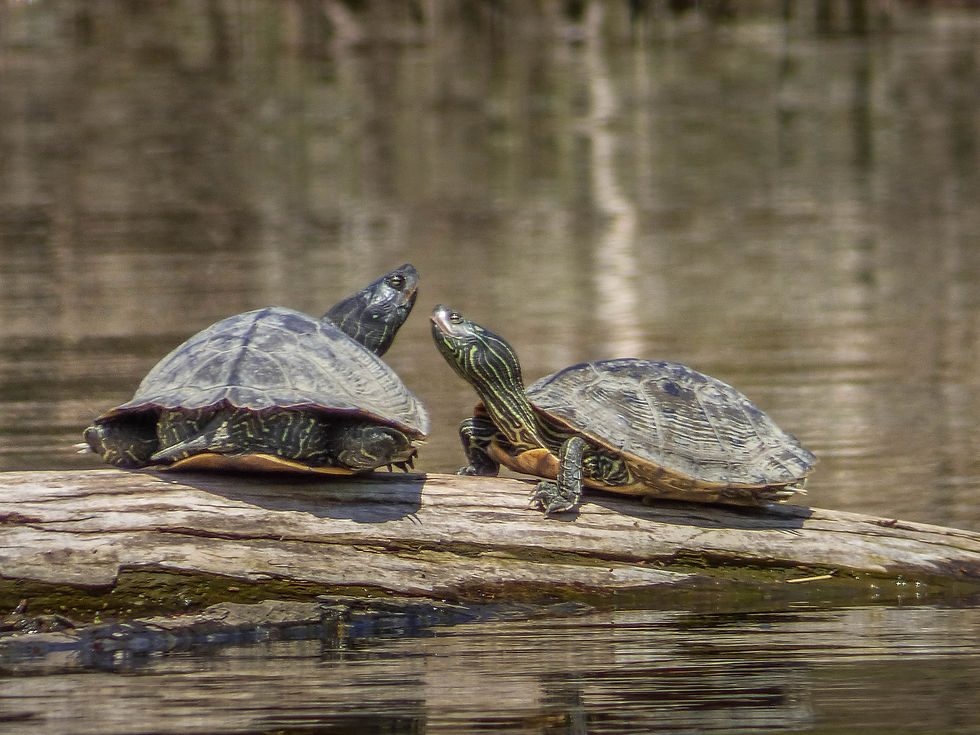Spring Finally Arrives
- Bruce Ause
- May 20, 2019
- 3 min read

Pasque Flowers
On April 20th, I had the opportunity to celebrate "Earth Day" by participating in an event sponsored by the Friends Of The Bluffs. According to Dave Anderson a member of the FOTB, over 800 people hiked to the top of Barn Bluff.
It was very exciting to see so much enthusiasm for this activity on a beautiful spring day. Once on top, there were many pasque flowers in bloom in the prairie area on the south exposure. Pasque flowers, sometimes called crocus, often bloom during Easter and are featured as the floral emblem for South Dakota.

Bloodroot
Recognizing that pasque flowers are the first spring flowers to appear on the prairie, bloodroots are some of the first woodland flowers to bloom. These spring ephemerals are short lived needing to reproduce before the leaf canopy develops. All parts of this plant have orange-red juice which was used by Native Americans for dye.

White Pelicans
For much of April and early May, the river level was at or above flood stage. This was at the peak stage of spring migration of white pelicans to their nesting rookeries in southwest Minnesota and eastern Dakotas.
Because the river levels were too high for the pelicans to feed successfully, numbers into the hundreds were being observed on Frontenac Pond. Many motorists were stopping along highway 61 to observe and photograph this unique spectacle.

White Pelicans Feeding
Unlike brown pelicans that dive headfirst into the water to feed, white pelicans eat mostly small fish that occur in shallow waters. They forage in groups by swimming on the surface, dipping their large bills to scoop up fish. Then raise their bills to drain water and swallow their prey.

Muskrat
As I mentioned in my last post, high water in Wacouta Pond has created ideal conditions for two Canada geese to find a place to feel quite comfortable adjacent to Wacouta Road for several weeks. In addition, I have observed a variety of wildlife from my car. This list includes mallards, wood ducks, grebes, blue herons, kingfishers and yes even a muskrat.
Muskrats are not really rats, but a common herbivore in our wetlands. The past couple years I have observed an increase in the number of these animals.

Hooded Merganser
One of the more colorful and interesting birds I observed at the edge of the pond was a drake hooded merganser. Like wood ducks, they also nest in tree cavities or artificial nesting boxes.
Mergansers usually arrive a week before wood ducks which increases competition for nest sites. In the morning of April 29th, I observed a hen merganser with her brood of ten ducklings swimming near the road. It is quite rare to observe wood duck ducklings this early.

Blue Heron
To take advantage of the high water conditions enhancing our ability to travel through the flooded backwaters, John Tittle and I launched my canoe early in the morning of April 25th. One of our objectives was to observe and photograph activity in a Cannon Bottoms great blue heron rookery.

Nesting Great Blue Heron
Great blue herons nest primarily in the tops of tall trees. The nests are constructed in 3 to 10 days and are made of small sticks collected from the ground or nearby shrubs.
I have always been amazed how many young nestlings can successfully fledge from such flimsy looking structures. After a severe June windstorm in the early 1970's, I kayaked into a Cannon bottoms rookery and discovered numerous young herons injured or dead on the ground below the nests.. They no doubt became sustenance for a variety of wildlife thus completing the "circle of life."
Recent Paddling Trip with John Tittle into the Blue Heron Rookery. Thank you John for the video showing adults returning to the nests.

Northern Map Turtles
With the continued high water levels on the river, I decided on May 8th to paddle my canoe up into the flooded backwaters of Wacouta Bay. A very common observation on my outing was numerous turtles sunning themselves on floating logs.
Turtles are cold blooded and their body temperature matches the surrounding environment. As they absorb heat from the sun while on the logs, their metabolism increases giving them the energy to forage for food, escape predators and pursue mates.




Comments